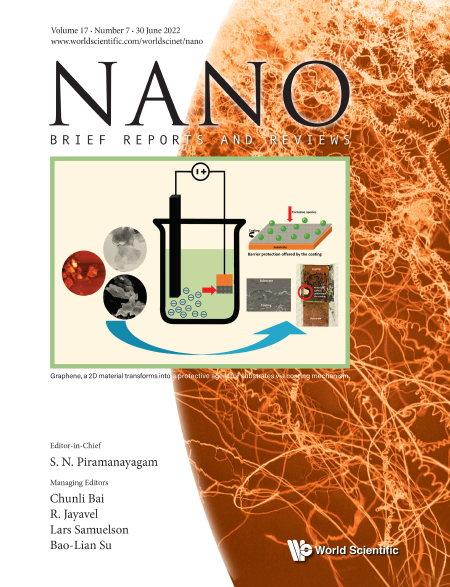Volume 17, Issue 07 (30 June 2022)
Electrophoresed Graphene Coatings for Corrosion Prevention: A Review
2230004
https://doi.org/10.1142/S1793292022300043

Graphene sheets are synthesized and coated via electrophoretic deposition. These coatings can have numerous applications. However, their role as anti-corrosive coatings is quite significant and much exploration has been invested in this direction. This article provides an outlook in the area of graphene coatings as anti-corrosive barrier.
Nickel Pyrophosphate Nanoparticles: Synthesis, Structural, Thermal, Spectroscopic, and Dielectric Studies
- P. D. Solanki,
- Mahatta H. Oza,
- H. O. Jethwa,
- Jaydeep Joshi,
- Girish Joshi,
- R. Jayavel, and
- M. J. Joshi
2250049
https://doi.org/10.1142/S1793292022500497

Nickel pyrophosphate was synthesized by surfactant mediated approach. Both the dielectric constant and loss have classical typical nature as the frequency increases the value of dielectric constant and loss decreases. The a.c. conductivity increased with increasing frequency and followed Jonscher’s Power law. The variation in the value of exponent n with temperature indicated small polaron QMT mechanism of a.c. conduction. The high value of dielectric constant may find application in energy storage devices. The temperature of sample had pronounced influence on the dielectric properties like; dielectric constant, a.c. conductivity, and dielectric loss up to 120∘C, and thereafter because of the dehydration process occurring in the samples, the nature was altered. From cyclic voltammetry, the maximum specific capacitance is found to be 406.33 F/g for scan rate 5 mVs–1. When scan rate increases to 100 mVs–1, the specific capacitance decreases and the lowest value is found to be 49.5 F/g for 100 mVs–1 scan rates.
Synthesis of Li1.2Mn0.54Ni0.13Co0.13O2 Nanorods by a Facile Self-Template Method and their Electrochemical Performances
- Jinjin Wang,
- Xinlu Wang,
- Qingnan Feng,
- Chenglong Shao,
- Guixia Liu,
- Wensheng Yu,
- Xiangting Dong, and
- Jinxian Wang
2250050
https://doi.org/10.1142/S1793292022500503

In this work, a facile self-template method was designed to fabricate Li1.2Mn0.54Ni0.13Co0.13O2 nanorods cathode materials by using rod-like Mn2O3 as template. The morphology and size of the as-prepared materials can be easily regulated by changing the temperature, and their eletrochemical performance of lithium-rich cathode material was further investigated. This work proposes a new approach to develop advanced cathode materials for LIBs applications.
How Light Polarizations Affect the Localized Surface Plasmon Resonance of Asymmetric Palladium Nanostructures
2250051
https://doi.org/10.1142/S1793292022500515

In the current research, diverse arrangements of asymmetric palladium nanostructures are illustrated by Transmission Electron Microscopy (TEM) images to investigate the characteristics of the Localized Surface Plasmon Resonance (LSPR). The optical response is measured using far field polarization spectroscopy and calculated using Finite Element Method (FEM). Depending on the light polarization angles, these nanostructures produced strong plasmonic coupling in close proximity of the nanoparticles that affected the LSPRs spectra. The main advantage of the transition metallic nanostructures lies in the generation of a highly enhanced electromagnetic field that can be exploited in diverse applications such as nanoplasmonics, nanomedicine and optoelectronics.
Enhanced Colloidal Stability of Silver Nanoparticles by Green Synthesis Approach: Characterization and Anti-Leishmaniasis Activity
- Maryam Samareh Salavati,
- Seyed Mohammad Amini,
- Maryam Nooshadokht,
- Arman Shahabi,
- Fatemeh Sharifi,
- Ali Afgar,
- Yaser Yousefpoor, and
- Mohamad Javad Mirzaei-Parsa
2250052
https://doi.org/10.1142/S1793292022500527

In the current study, silver nanoparticles were prepared with a green synthesis method. The colloidal stability of silver nanoparticles is important for their use in various fields, including medical applications. Therefore, different amounts of CMC were added in the synthesis process, to increase the stability of nanoparticles at least for 3 months in solution. Moreover, the apoptotic effect of these nanoparticles was compared with Glucantime®, which is the most common drug used in the treatment of leishmaniasis.
A Turn-On Fluorescent Probe for Determination of Ascorbic Acid Based on CaF2:Yb3+, Er3+ Upconversion Nanoparticles
2250053
https://doi.org/10.1142/S1793292022500539

The turn-on fluorometric probe was designed for the determination of ascorbic acid (AA) based on the inner filter effect (IFE) between CaF2:Yb3+,Er3+ NPs and the oxidized 3, 3′, 5, 5′-tetramethylbenzidine (oxTMB). The limit of detection (LOD) of AA is 0.1 μM, and it has been applied to the detection of AA in commercial vitamin C tablets.
The Superhydrophobic and Oleophobic Material Constructed with γ-AlOOH Micro-Nanostructure
- Menglong Chen,
- Rui Ma, and
- Qi Jiang
2250054
https://doi.org/10.1142/S1793292022500540

γ-AlOOH micro-nanostructure with special morphology was prepared by a simple hydrothermal method using common feedstock. Stearic acid was used as a hydrophobic modifier to obtain the superhydrophobic and oleophobic surface with good durability. Reaction conditions including reaction time, the valence anions, substrate and surfactant have a great influence on the morphology and wetting performance of γ-AlOOH structure. The surface hydroxyl group on substrate surface plays a guidance and orientation role in the growth of micro-nanostructure.
Effect of Polymer Structure on the Size and Shape of Metal and Metal Oxide Nanopowder: An HR-TEM Approach
- B. Meenarathi,
- A. Thamizhlarasan,
- L. Kannammal,
- S. Luna Eunice,
- A. Jancirani,
- A. Amala Jeya Ranchani, and
- R. Anbarasan
2250055
https://doi.org/10.1142/S1793292022500552

In the present research work, the various metal and metal oxide quantum dots by simultaneous oxidative reduction method have been prepared. The prepared quantum dots were characterized by HR-TEM to access the nanoparticle formed. The influence of polymer structure on the size and shape of the nanopowder was analyzed.
Structural and Electronic Properties of ZnO Bilayer and Twist Bilayer: A First-Principles Study
- Wen Yu,
- Xiao Wang, and
- Chuanguo Li
2250056
https://doi.org/10.1142/S1793292022500564

The band gap of the bilayers can be tuned by translation motion, and ZnO twist bilayer shows a better performance than the initial bilayer in this study.

